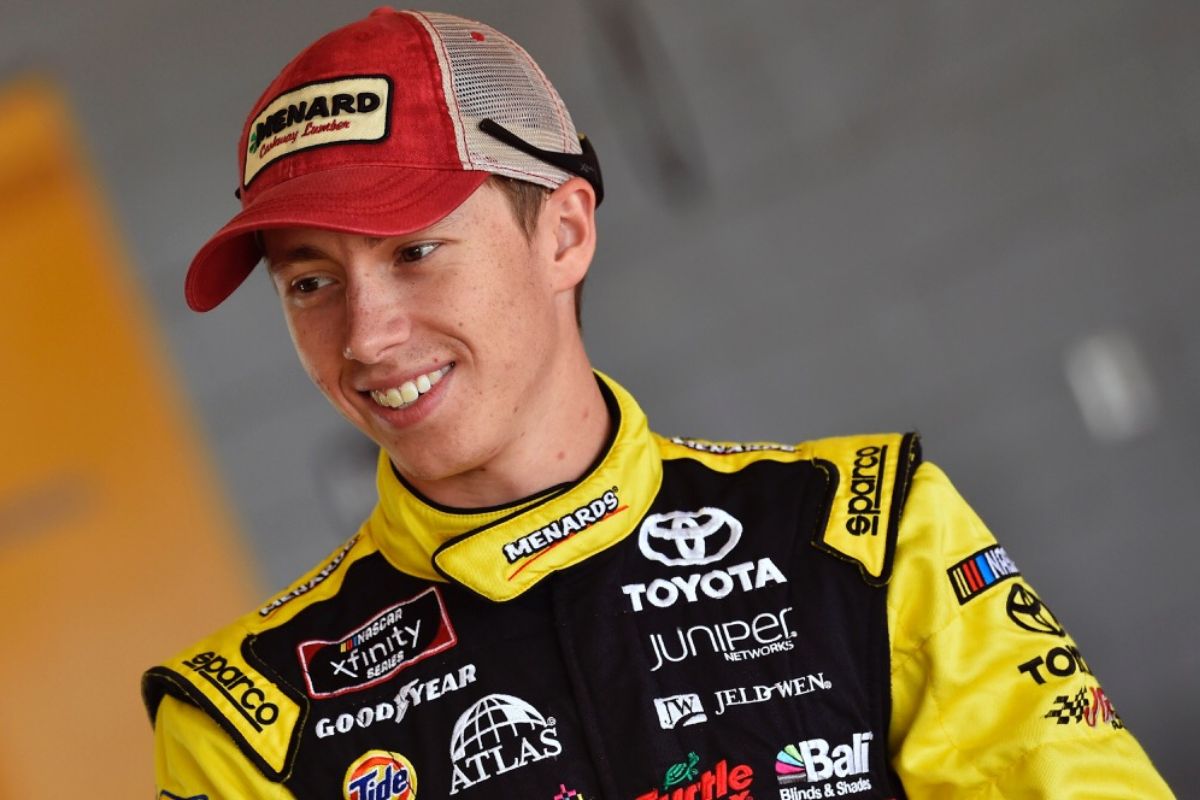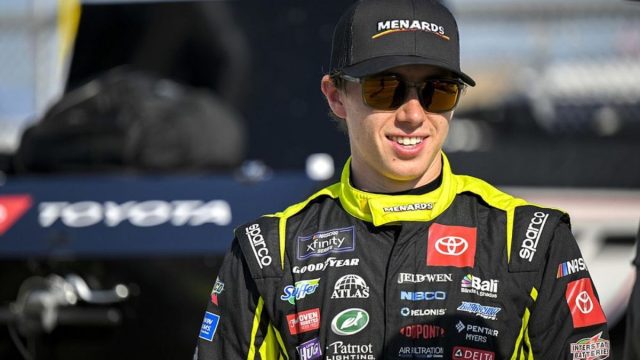Brandon Jones Car Catches Fire: In a dramatic turn at the ToyotaCare 250, Brandon Jones’ No. 9 Chevy Camaro encountered a disastrous mechanical failure, culminating in a fire during Stage 1 at Richmond Raceway. This incident underscores the risky balance between speed, reliability, and the inherent unpredictability of motorsport. The attempted restart, hindered by oil leakage, led to Jones’ premature exit, highlighting the critical importance of vehicle assessment post-incident. Further analysis pointed towards drivetrain and oil line failures, spotlighting the necessity for continuous technological advancements in safety and performance. The unfolding drama at Richmond Raceway serves as a stark reminder of the challenges teams face, inviting a deeper examination of the complex dynamics of NASCAR racing.
Key Takeaways
- Brandon Jones’ No. 9 Chevy Camaro suffered a drivetrain failure, leading to a spin and collision at Richmond Raceway.
- An attempt to restart the vehicle post-spin resulted in a fire due to oil leakage, forcing Jones to withdraw from the race.
- The incident caused an extended caution on the track, significantly impacting race dynamics and strategies of other drivers.
- Brennan Poole seized the opportunity for a strategic tire change during the caution, gaining an advantage over competitors.
- The incident and subsequent caution period highlighted the unpredictable nature of NASCAR Xfinity Series events and the importance of quick strategic decisions.
Brandon Jones’ Misfortune at ToyotaCare 250
At the ToyotaCare 250 NASCAR Xfinity race at Richmond Raceway, Brandon Jones, behind the wheel for JR Motorsports, encountered a significant setback due to a mechanical failure that prematurely ended his pursuit of victory. This incident not only marked a pivotal moment in the race but also underscored the unpredictable nature of motorsport, where even the most meticulously prepared plans can unravel in the blink of an eye.
Jones, a seasoned driver with a solid track record, had entered the race with high expectations. The mechanical failure, however, highlighted an essential aspect of racing that often goes unnoticed by the casual observer: the intricate balance between speed and reliability. In the high-octane world of NASCAR, where vehicles are pushed to their limits, the durability of every component is tested. Jones’ misfortune serves as a strong reminder of the fine line teams and drivers walk on race day.
Moreover, this incident sheds light on the rigorous demands placed on teams and their engineering squads. The preparation for a race extends far beyond the visible efforts on the track. It encompasses countless hours of testing, tuning, and troubleshooting to make sure that the car can withstand the rigors of competition. The breakdown of Jones’ vehicle is a proof of the relentless challenge teams face in maintaining peak performance under extreme conditions.
To the discerning eye, Jones’ setback at Richmond Raceway is not merely a tale of misfortune but a narrative rich with insights into the complexities of motorsport. It underscores the essence of racing: a relentless pursuit of excellence amidst the ever-present shadow of unpredictability.

Race Incident and Mechanical Failure
Reflecting further on Brandon Jones’ unfortunate experience at the ToyotaCare 250, the race incident involving his No. 9 Chevy Camaro not only highlighted the hazards inherent in motorsport but also brought mechanical vulnerability to the forefront of racing challenges. The episode unfolded as an ideal reminder of how swiftly fortunes can turn on the racetrack, underlining the critical nature of mechanical integrity in the high-stakes environment of competitive racing.
The moment Jones attempted to move around pole sitter Parker Retzlaff, his vehicle succumbed to a drivetrain failure, a critical component responsible for transmitting power from the engine to the wheels. This mechanical malfunction not only precipitated an immediate loss of control, leading to Jones’ spin out but also underscored the intricate balance between aggressive racing tactics and the mechanical limits of racing machinery. The subsequent collision with the outside barriers, compounded by the vehicle’s continued leakage of oil onto the track, magnified the incident’s severity, affecting not only Jones but potentially the safety of other racers and the race’s overall integrity.
This incident serves as a stark reminder of the relentless pursuit of reliability and performance within motorsport engineering. It emphasizes the importance of rigorous pre-race inspections and continuous monitoring of vehicle health, especially in the context of NASCAR, where the fine line between triumph and disaster can often be traced back to mechanical resilience. Such episodes provoke thoughtful consideration on the part of teams, engineers, and drivers alike, towards achieving a perfect balance between pushing the envelope of performance and ensuring the mechanical soundness necessary to withstand the rigors of competition.
— FOX: NASCAR (@NASCARONFOX) March 30, 2024
Attempted Restart and Fire
In a dramatic turn of events, Brandon Jones’ attempt to restart his No. 9 Chevy Camaro following a spin resulted in a fire outbreak, a consequence of oil leaking from the vehicle’s front left side, which ultimately led to his withdrawal from the ToyotaCare 250 race. The attempted restart, an instinctive response to salvage the race, inadvertently became the catalyst for the fire. The incident underscores the delicate balance between the will to continue and the critical assessment of a vehicle’s condition post-incident.
| Aspect | Detail | Impact |
|---|---|---|
| Spin | Initial spin leading to attempt to restart | Precursor to fire |
| Oil Leak | Front left side of the vehicle | Direct cause of fire |
| Fire Outbreak | Engulfed the front end | Immediate withdrawal from race |
| Safety Measures | Efforts to extinguish fire | Highlighted the importance of rapid response |
This sequence of events not only illuminates the unpredictable nature of motorsports but also accentuates the importance of swift decision-making and the inherent risks of attempting to rejoin a race without a thorough assessment of the vehicle’s integrity. The leakage of oil, a highly flammable substance, particularly under the heat conditions generated by high-performance engines, represents a critical vulnerability in racing scenarios.
The incident at Richmond Raceway serves as a stark reminder of the fine line that drivers navigate between aggression and caution. Analyzing this occurrence provides invaluable insights into the dynamics of race-car behavior post-incident, emphasizing the need for a balance between competitive spirit and the overarching priority of safety.
A mechanical failure on the No. 9 sends @BrandonJonesRac spinning into the wall. pic.twitter.com/9R9aYxUIxS
— NASCAR Xfinity (@NASCAR_Xfinity) March 30, 2024
Post-Incident Analysis
Following the fiery incident at Richmond Raceway, a thorough post-incident analysis by Brandon Jones revealed potential mechanical failures, specifically with the drivetrain and oil line, as the culprits behind the dramatic event. Jones described the onset of the issue as sudden, with the drivetrain beginning to shake violently before locking up, which was immediately followed by the car erupting into flames. This unexpected sequence of events underscores the unpredictable nature of mechanical failures in high-stress racing environments.
The analysis points to several critical insights:
- Drivetrain Durability: High-performance racing vehicles are subjected to extreme conditions that can push mechanical components beyond their limits. The drivetrain’s failure suggests a potential oversight in its design or maintenance, emphasizing the need for rigorous testing and evaluation.
- Oil Line Integrity: The leakage from the oil line indicates a vulnerability in the vehicle’s fluid management system. Such leaks not only pose a fire hazard but also compromise the engine’s lubrication and cooling, leading to catastrophic failures.
- Unexpected Failure Modes: Despite advancements in racing technology and safety, the incident highlights that unexpected failure modes can still occur, necessitating continuous improvement in vehicle diagnostics and monitoring systems.
- Safety Protocols: The rapid response to the fire underscores the importance of having robust safety protocols in place. However, it also prompts a review of preventive measures to mitigate the risk of such incidents in the future.
This analysis not only sheds light on the technical aspects of the failure but also serves as a reminder of the inherent risks in motorsport, driving the push for advancements in vehicle safety and reliability.
“It is kind of hard to process at once, when it happened. Got into [Turn] three and pretty much the whole drivetrain kept shaking and locking up really hard and then I spun. That’s just oil blowing all over the track.”
Impact on the Race and Poole’s Strategy
The car fire incident involving Brandon Jones at Richmond Raceway precipitated an extended caution on the track, considerably altering the competitive landscape and providing a strategic advantage to Brennan Poole, who opted for a timely tire change. This decision, made amidst the chaos and unpredictability that enveloped the race following the incident, showcased a high level of strategic acumen. Poole’s team, seizing the moment of extended caution, assessed the evolving race conditions and opted for fresh tires, a move that not only showcased foresight but also leveraged the situation to their advantage.
The impact of the extended caution cannot be overstated. It served as a leveling field for the competitors, but it was Poole’s strategic tire change that distinguished his approach from the rest. As the race resumed, the advantage gained from this decision became evident. The fresh tires provided Poole with superior grip and maneuverability on the track, allowing him to navigate through the field more effectively and gain significant positions. This strategic move was not just about immediate gains; it was a calculated effort to amass valuable stage points, pivotal for the championship standings.
As the race unfolded, the competition intensified, demonstrating the dynamic and unpredictable nature of NASCAR Xfinity Series events, especially at a venue as challenging as Richmond Raceway. Poole’s strategy, underscored by the timely decision to change tires, exemplified how pivotal moments, such as the extended caution caused by Jones’ car fire, can be leveraged to alter the course of the race. This incident and the subsequent strategic decisions highlighted the intricate balance between risk management and strategic aggressiveness in NASCAR racing.

News in Brief
The incident involving Brandon Jones’ vehicle at the ToyotaCare 250 not only highlighted the unpredictable nature of motorsports but also underscored the importance of quick decision-making and mechanical reliability.
The subsequent fire after an attempted restart served as a stark reminder of the inherent risks faced by competitors.
This event had a profound impact on the tactical considerations of other racers, particularly Poole, altering the competitive dynamics of the race.
Such occurrences emphasize the critical need for continuous advancements in safety and vehicle performance within the racing industry.
Our Reader’s Queries
Q: Who does Brandon Jones drive for now?
A:Brandon Jones pilots the No. 9 JR Motorsports Chevrolet in the Xfinity Series, marking his second season with the team. Jones secured a victory at Martinsville Speedway during the eighth race of the 2022 season.
Q: How many wins does Brandon Jones have?
A: Jones has been a consistent presence in the NXS since 2016, securing five victories and qualifying for the NXS Playoffs six times. Throughout his NXS career, which began in 2015, the Georgia native has achieved 39 top-five and 111 top-10 finishes in 269 starts, leading 876 laps.
Q: Is Brandon Jones in a relationship?
A: Bachelor in Paradise’s Brandon Jones and Serene Russell have called off their engagement, announcing the news on Monday (May 8). In an Instagram statement, they shared, “After many months, today we have ultimately decided to end our engagement.”
Also Read: Chandler Smith Wins 2024 ToyotaCare 250: Victory at Richmond Speedway
